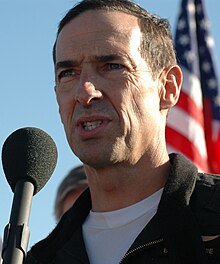Brian Binnie
William Brian Binnie | |
|---|---|
 Binnie in 2004 | |
| Born | 1953 (age 70–71) West Lafayette, Indiana, U.S. |
| Nationality | American |
| Occupation | Test pilot |
| Space career | |
| Commercial astronaut | |
| Rank | Commander, United States Navy |
Time in space | ~5 minutes |
| Selection | SpaceShipOne 2003 |
| Missions | SpaceShipOne flight 17P |
William Brian Binnie (born 1953) is a former United States Navy officer and one of the test pilots for SpaceShipOne, the experimental spaceplane developed by Scaled Composites and flown from 2003–2004.
History

Binnie was born in West Lafayette, Indiana, where his Scottish father William P. Binnie was a professor of physics at Purdue University. The family returned to Scotland when Binnie was five, and lived in Aberdeen (his father taught at Aberdeen University) and later in Stirling.[1] When Binnie was a teenager the family moved to Boston.[2]
Binnie, an alumnus of Brown and Princeton Universities, served for 21 years in the United States Navy as a naval aviator flying the A-7 Corsair II, A-6 Intruder, F/A-18 Hornet, and AV-8B Harrier II. He graduated from the U.S. Naval Test Pilot School in 1988. Binnie also copiloted the Atmospheric Test Vehicle of the Rotary Rocket. In 2006, he received an Honorary degree from University of Aberdeen.[3]
SpaceShipOne and spaceflight

On December 17, 2003, the 100th anniversary of the Wright brothers' first powered flight, Binnie piloted the first powered test flight of SpaceShipOne, flight 11P, which reached a top speed of Mach 1.2 and a height of 12.9 miles (20.7 km). On October 4, 2004, he piloted SpaceShipOne's second Ansari X Prize flight, flight 17P, winning the X Prize and becoming the 435th person to go into space. His flight, which peaked at 367,442 feet (69.6 mi; 112.0 km), set a winged aircraft altitude record,[4] breaking the old record set by the North American X-15 in 1963.[5] It also earned him the second set of Astronaut Wings to be given by the FAA for a flight aboard a privately operated commercial spacecraft.[6]
Post Scaled Composites
In 2014 Binnie joined XCOR Aerospace as senior engineer and test pilot, after working as a test pilot and program business manager for Scaled Composites for many years.[7]
Quotes
I wake up every morning and thank God I live in a country where all of this is possible. Where you have the Yankee ingenuity to roll up your sleeves, get a band of people who believe in something and go for it and make it happen. It doesn't happen anywhere else.
— Brian Binnie, October 4, 2004, after completing flight 17P[5]
References
- ^ "Stirling has a space ace". Stirling Observer. July 19, 2006. Retrieved November 4, 2006.
- ^ Kiely, Kathy (February 23, 2005). "Rocket man". Princeton Alumni Weekly. Retrieved November 4, 2006.
- ^ "Degree for 'first Scot in space'". BBC News. July 3, 2006. Retrieved November 4, 2006.
- ^ "FAI Record ID #9881 – Altitude above the earth's surface with or without maneuvres of the aerospacecraft, Class P-1 (Suborbital missions) Archived October 18, 2015, at the Wayback Machine" Mass Archived September 24, 2015, at the Wayback Machine Time Archived September 24, 2015, at the Wayback Machine Fédération Aéronautique Internationale (FAI). Retrieved: 21 September 2014.
- ^ a b Brekke, Dan (October 4, 2004). "SpaceShipOne Wins the X Prize". Wired. Retrieved November 4, 2006.
- ^ "Active Commercial Space Licenses". FAA.gov. Retrieved May 3, 2009.
- ^ Klotz, Irene (April 3, 2014). "Spaceship Pilot Joins Rival Firm". Space News. Retrieved April 4, 2014.
External links
- 1953 births
- Living people
- American astronauts
- Aviators from Indiana
- Brown University alumni
- Princeton University alumni
- Commercial astronauts
- Scaled Composites
- Scaled Composites Tier One program
- United States Navy officers
- United States Naval Aviators
- American test pilots
- Flight altitude record holders
- American people of Scottish descent
- American aviation record holders

